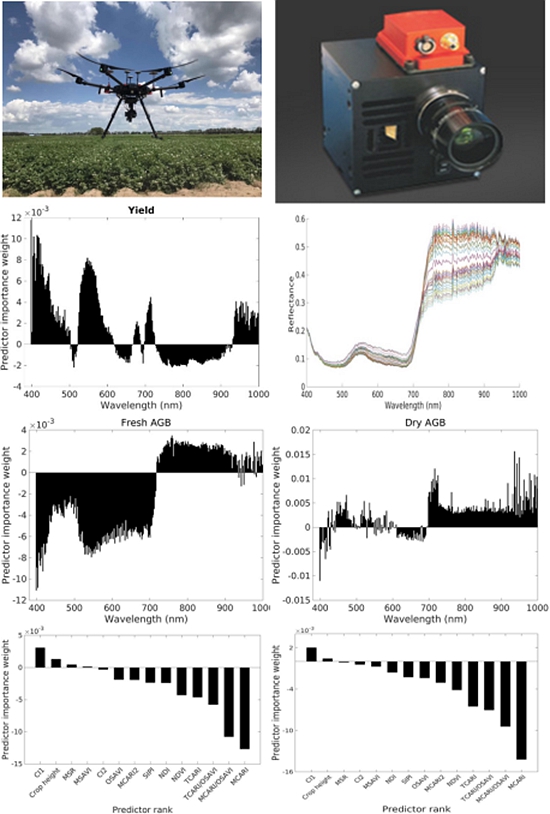Above-ground Biomass Estimation and Yield Prediction in Potato by Using UAV-based RGB and Hyperspectral Imaging
Recently, an article entitled Above-ground biomass estimation and yield prediction in potato by using UAV-based RGB and hyperspectral imaging completed by Prof. Jin Liping’s lab at Institute of Vegetables and Flowers of CAAS was published in the ISPRS Journal of Photogrammetry and Remote Sensing (5-year IF = 8.597). This work mainly focuses on methods for accurate inversion of the biomass estimation and yield prediction in potato by UAV remote sensing. Additionally, it can be used to assist in site-specific crop management with high resource use efficiency.
Improving potato production without negative environmental consequences is important for ensuring global food security. Understanding the spatio-temporal dynamics of Above-ground biomass (AGB) and its relationship to yield is essential for developing and implementing site-specific crop husbandry measures. Researchers explored the methods for improving the accuracy of quantitative remote sensing inversion model for predicting biomass and yield of potato. Multiple VIs derived from hyperspectral imaging data and plant heights measured using an nDSM-based method were used as predictor variables in random forest (RF) and partial least squares regression (PLSR) modelling. Combining with crop height and two narrow-band vegetation indices (CI1 and MSR) selected by the RReliefF feature selection algorithm were selected as the most important predictors. Random Forest regression models demonstrated high prediction accuracy for both fresh and dry above-ground biomass, with a coefficient of determination (R2) > 0.90. Crop yield was predicted using four narrow-band vegetation indices and crop height (R2 = 0.63) with imagery data obtained 90 days after planting. A Partial Least Squares regression model based on the full wavelength spectra demonstrated improved yield prediction (R2 = 0.81). The research team concluded that the RF regression model had better prediction accuracy compared to the PLS regression model based on the full spectra in terms of AGB, Conversely, the PLS regression model performed better than the RF regression model in predicting potato yield. Yield prediction using survey data one month prior to harvesting was satisfactory. It is worth mentioned that UAV-based hyperspectral imaging is a promising remote sensing technique for predicting potato AGB and yield under complex environments (eg. Multi varieties, nutrient and water supply, small plots et al.), and can be adopted for site-specific crop management.
The study was supported by the National Key Research and Development Program of China (2018YFD0200803), China Agriculture Research System (CARS-09-P12), Breeding new varieties for advantageous agricultural industries in Ningxia-Digital breeding system
for potato (2019NYYZ01-4) and Agri-Tech in China: Newton Network +, UK (LG005).

Figure UAV hyperspectral remote sensing for above-ground biomass estimation and yield prediction
The URL for relevant article are shown below:
http://www.sciencedirect.com/science/article/abs/pii/S0924271620300538
By Liu Jiangang (liujiangang@caas.cn)
-
 Apr 18, 2024Opening Ceremony of the Training Workshop on Wheat Head Scab Resistance Breeding and Pest Control in Africa Held in CAAS
Apr 18, 2024Opening Ceremony of the Training Workshop on Wheat Head Scab Resistance Breeding and Pest Control in Africa Held in CAAS -
 Apr 03, 2024IPPCAAS Co-organized the Training Workshop on Management and Application of Biopesticides in Nepal
Apr 03, 2024IPPCAAS Co-organized the Training Workshop on Management and Application of Biopesticides in Nepal -
 Mar 28, 2024Delegation from the School of Agriculture and Food Science of University College Dublin, Ireland Visit to IAS, CAAS
Mar 28, 2024Delegation from the School of Agriculture and Food Science of University College Dublin, Ireland Visit to IAS, CAAS -
 Mar 25, 2024Director of World Food Prize Foundation visited GSCAAS
Mar 25, 2024Director of World Food Prize Foundation visited GSCAAS -
 Mar 20, 2024Institute of Crop Sciences (ICS) and Syngenta Group Global Seeds Advance Collaborative Research in the Seed Industry
Mar 20, 2024Institute of Crop Sciences (ICS) and Syngenta Group Global Seeds Advance Collaborative Research in the Seed Industry
